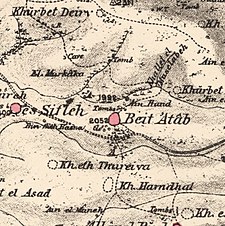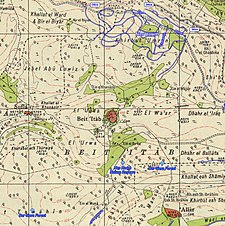Bayt 'Itab
بيت عطاب Beit 'Atab, Bait 'Itab | |
|---|---|
 Bayt 'Itab | |
| Etymology: ""House of Atab"[1] | |
A series of historical maps of the area around Bayt 'Itab (click the buttons) | |
Location within Mandatory Palestine | |
| Coordinates: 31°44′06″N 35°03′11″E / 31.73500°N 35.05306°E | |
| Palestine grid | 155/126 |
| Geopolitical entity | Mandatory Palestine |
| Subdistrict | Jerusalem |
| Date of depopulation | 21 October 1948[4] |
| Area | |
| • Total | 5,447 dunams (5.447 km2 or 2.103 sq mi) |
| Population (1945) | |
| • Total | 540[2][3] |
| Cause(s) of depopulation | Military assault by Yishuv forces |
| Current Localities | Nes Harim[5] |
Bayt ʿIṭāb (Arabic: بيت عطاب) was a Palestinian Arab village located in the Jerusalem Subdistrict. The village is believed to have been inhabited since the biblical period. An ancient tunnel which led to the village spring is associated with the story of Samson.[citation needed] Both during and after its incorporation into Crusader fiefdoms in the 12th century, its population was Arab. Sheikhs from the Lahham family clan, who were associated with the Qays tribo-political faction, ruled the village during Ottoman era. In the 19th century, this clan controlled 24 villages in the vicinity. The homes were built of stone. The local farmers cultivated cereals, fruit trees and olive groves and some engaged in livestock breeding.
After a military assault on Bayt ʿIṭāb by Israeli forces in October 1948, the village was depopulated and demolished.[6] Many of the villagers had fled to refugee camps in the West Bank less than 20 kilometres (12 mi) from the village. In 1950, an Israeli moshav, Nes Harim, was established north of the built up portion of Bayt 'Itab, on an adjacent peak.[7]
- ^ Palmer, 1881, p. 186
- ^ Department of Statistics, 1945, p. 24
- ^ a b Government of Palestine, Department of Statistics. Village Statistics, April, 1945. Quoted in Hadawi, 1970, p. 56
- ^ Morris, 2004, p. xx, village #343. Also gives cause of depopulation
- ^ Khalidi, 1992, p. 275
- ^ Cite error: The named reference
Benvenistip301was invoked but never defined (see the help page). - ^ "ERETZ Magazine". www.eretz.com.




